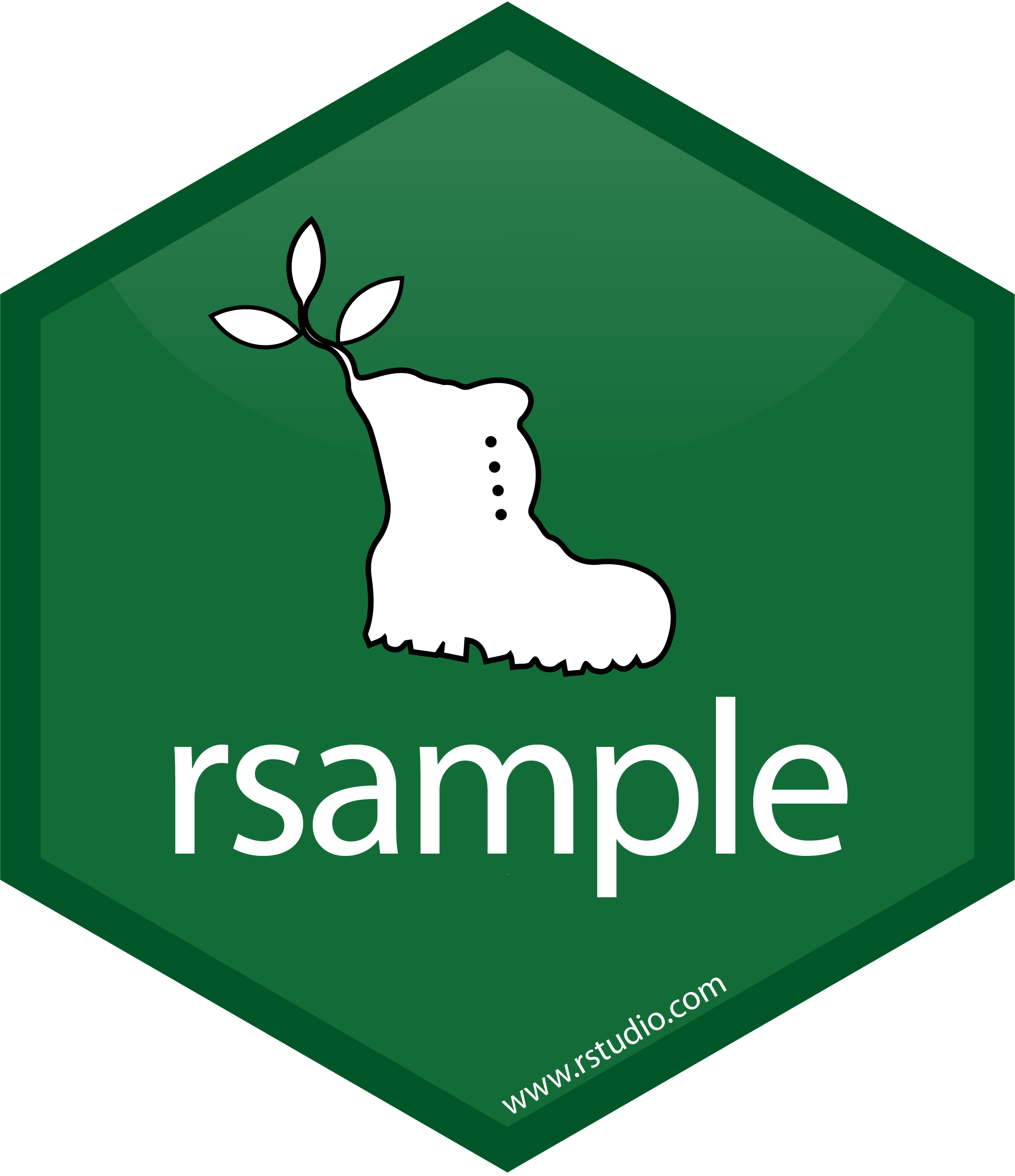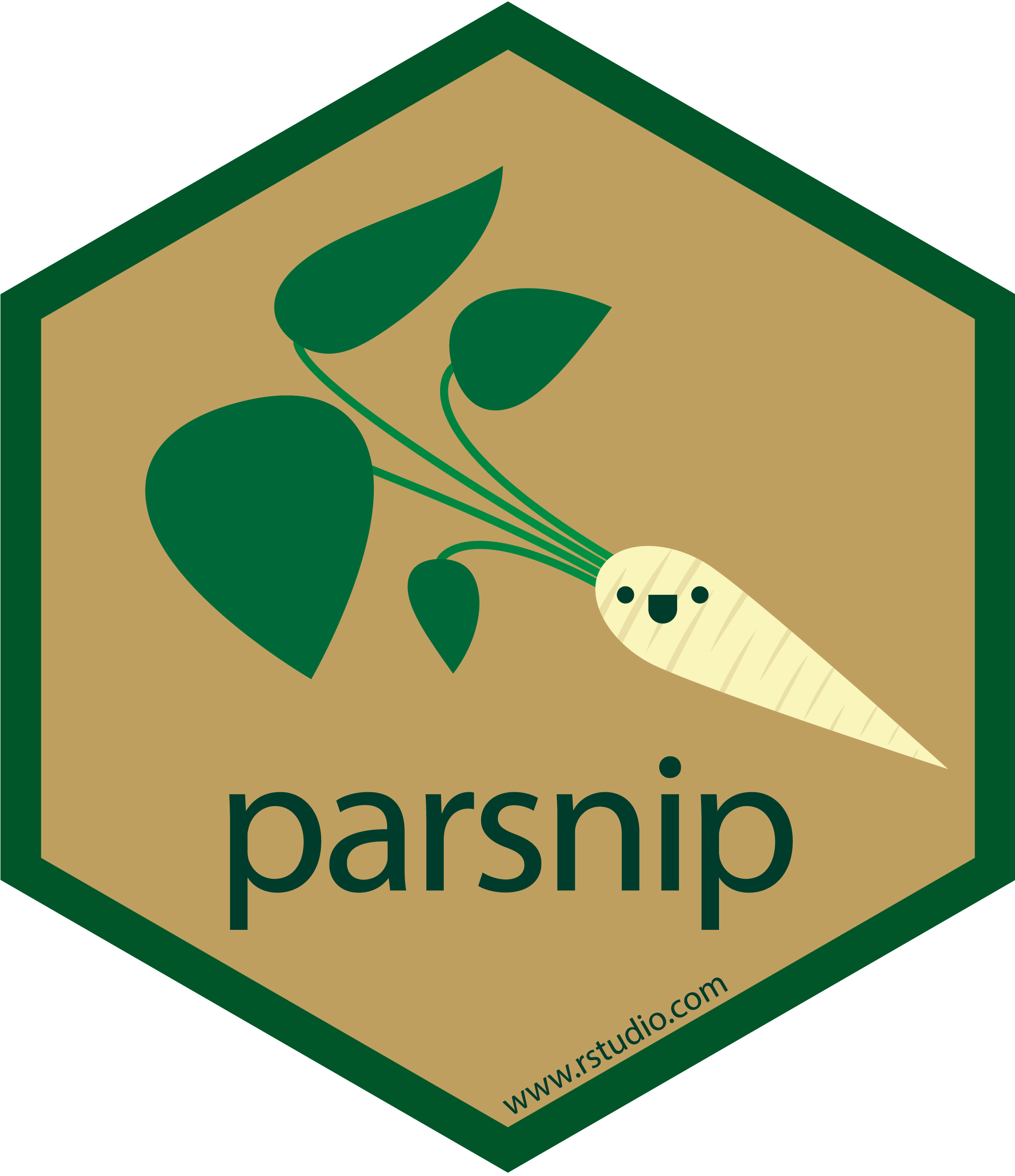library(tidymodels)
library(tidyverse)
abalone <- read_csv("abalone.csv") %>% mutate_if(is.character, as.factor)
set.seed(123)
ring_split <- initial_split(abalone, prop = 0.8, strata = rings)
ring_train <- training(ring_split)
ring_test <- testing(ring_split)
set.seed(234)
ring_folds <- vfold_cv(ring_train, v = 5, strata = rings)
ring_folds
#> # 5-fold cross-validation using stratification
#> # A tibble: 5 × 2
#> splits id
#> <list> <chr>
#> 1 <split [2670/670]> Fold1
#> 2 <split [2672/668]> Fold2
#> 3 <split [2672/668]> Fold3
#> 4 <split [2673/667]> Fold4
#> 5 <split [2673/667]> Fold55 - Feature engineering
Machine learning with tidymodels
Build better predictors 🛠️
- Some models require predictors with certain characteristics or a certain format
- Some datasets are better modeled when one or more predictors are transformed
Artwork by @allison_horst
Build better predictors 🛠️ ![]()
Statistical parameters for recipe steps can be estimated from an initial data set and then applied to other data sets
The resulting features can be used as inputs for statistical or machine learning models
Abalone data spending ![]()
A first recipe ![]()
The recipe() function assigns columns to roles of “outcome” or “predictor” using the formula
A first recipe ![]()
summary(ring_rec)
#> # A tibble: 9 × 4
#> variable type role source
#> <chr> <chr> <chr> <chr>
#> 1 sex nominal predictor original
#> 2 length numeric predictor original
#> 3 diameter numeric predictor original
#> 4 height numeric predictor original
#> 5 whole_weight numeric predictor original
#> 6 shucked_weight numeric predictor original
#> 7 viscera_weight numeric predictor original
#> 8 shell_weight numeric predictor original
#> 9 rings numeric outcome originalA first recipe ![]()
Create indicator variables ![]()
| rings | length | diameter | height | whole_weight | shucked_weight | viscera_weight | shell_weight | sex_infant | sex_male |
|---|---|---|---|---|---|---|---|---|---|
| 7 | 0.350 | 0.265 | 0.090 | 0.226 | 0.100 | 0.048 | 0.070 | 0 | 1 |
| 7 | 0.330 | 0.255 | 0.080 | 0.205 | 0.090 | 0.040 | 0.055 | 1 | 0 |
| 7 | 0.355 | 0.280 | 0.085 | 0.290 | 0.095 | 0.040 | 0.115 | 1 | 0 |
| 7 | 0.365 | 0.295 | 0.080 | 0.256 | 0.097 | 0.043 | 0.100 | 0 | 1 |
| 8 | 0.465 | 0.355 | 0.105 | 0.480 | 0.227 | 0.124 | 0.125 | 0 | 1 |
| 8 | 0.450 | 0.355 | 0.105 | 0.522 | 0.237 | 0.116 | 0.145 | 0 | 0 |
| 5 | 0.240 | 0.175 | 0.045 | 0.070 | 0.032 | 0.024 | 0.020 | 1 | 0 |
| 5 | 0.205 | 0.150 | 0.055 | 0.042 | 0.025 | 0.015 | 0.012 | 1 | 0 |
| 4 | 0.210 | 0.150 | 0.050 | 0.042 | 0.018 | 0.013 | 0.015 | 1 | 0 |
| 7 | 0.390 | 0.295 | 0.095 | 0.203 | 0.088 | 0.045 | 0.075 | 1 | 0 |
Normalization ![]()
| rings | length | diameter | height | whole_weight | shucked_weight | viscera_weight | shell_weight | sex_infant | sex_male |
|---|---|---|---|---|---|---|---|---|---|
| 7 | -1.453 | -1.444 | -1.284 | -1.228 | -1.166 | -1.203 | -1.215 | -0.683 | 1.307 |
| 7 | -1.620 | -1.545 | -1.545 | -1.270 | -1.211 | -1.286 | -1.323 | 1.463 | -0.765 |
| 7 | -1.411 | -1.292 | -1.414 | -1.095 | -1.187 | -1.286 | -0.888 | 1.463 | -0.765 |
| 7 | -1.327 | -1.140 | -1.545 | -1.166 | -1.178 | -1.254 | -0.997 | -0.683 | 1.307 |
| 8 | -0.489 | -0.532 | -0.891 | -0.708 | -0.592 | -0.511 | -0.816 | -0.683 | 1.307 |
| 8 | -0.615 | -0.532 | -0.891 | -0.619 | -0.547 | -0.580 | -0.671 | -0.683 | -0.765 |
| 5 | -2.374 | -2.356 | -2.461 | -1.546 | -1.473 | -1.433 | -1.577 | 1.463 | -0.765 |
| 5 | -2.668 | -2.610 | -2.200 | -1.604 | -1.500 | -1.511 | -1.635 | 1.463 | -0.765 |
| 4 | -2.626 | -2.610 | -2.330 | -1.604 | -1.536 | -1.533 | -1.613 | 1.463 | -0.765 |
| 7 | -1.118 | -1.140 | -1.153 | -1.274 | -1.220 | -1.235 | -1.178 | 1.463 | -0.765 |
Reduce correlation ![]()
| rings | height | shucked_weight | shell_weight | sex_infant | sex_male |
|---|---|---|---|---|---|
| 7 | -1.284 | -1.166 | -1.215 | -0.683 | 1.307 |
| 7 | -1.545 | -1.211 | -1.323 | 1.463 | -0.765 |
| 7 | -1.414 | -1.187 | -0.888 | 1.463 | -0.765 |
| 7 | -1.545 | -1.178 | -0.997 | -0.683 | 1.307 |
| 8 | -0.891 | -0.592 | -0.816 | -0.683 | 1.307 |
| 8 | -0.891 | -0.547 | -0.671 | -0.683 | -0.765 |
| 5 | -2.461 | -1.473 | -1.577 | 1.463 | -0.765 |
| 5 | -2.200 | -1.500 | -1.635 | 1.463 | -0.765 |
| 4 | -2.330 | -1.536 | -1.613 | 1.463 | -0.765 |
| 7 | -1.153 | -1.220 | -1.178 | 1.463 | -0.765 |
Dimensionality reduction ![]()
| rings | PC1 | PC2 | PC3 | PC4 | PC5 |
|---|---|---|---|---|---|
| 7 | -2.930 | 2.248 | -0.254 | 0.297 | -0.143 |
| 7 | -4.017 | -0.495 | 0.308 | 0.346 | -0.117 |
| 7 | -3.570 | -0.608 | 0.352 | 0.191 | -0.191 |
| 7 | -2.786 | 2.207 | -0.228 | 0.306 | 0.073 |
| 8 | -1.309 | 1.838 | -0.038 | 0.151 | 0.362 |
| 8 | -1.541 | 0.133 | -1.173 | 0.356 | 0.253 |
| 5 | -5.254 | -0.193 | 0.229 | 1.113 | -0.299 |
| 5 | -5.442 | -0.142 | 0.193 | 1.078 | -0.653 |
| 4 | -5.486 | -0.133 | 0.193 | 1.116 | -0.584 |
| 7 | -3.480 | -0.625 | 0.318 | -0.156 | 0.053 |
Build nonlinear features ![]()
| rings | length | diameter | height | whole_weight | viscera_weight | shell_weight | sex_infant | sex_male | shucked_weight_ns_1 | shucked_weight_ns_2 | shucked_weight_ns_3 | shucked_weight_ns_4 |
|---|---|---|---|---|---|---|---|---|---|---|---|---|
| 7 | -1.453 | -1.444 | -1.284 | -1.228 | -1.203 | -1.215 | -0.683 | 1.307 | 0.031 | -0.181 | 0.392 | -0.211 |
| 7 | -1.620 | -1.545 | -1.545 | -1.270 | -1.286 | -1.323 | 1.463 | -0.765 | 0.023 | -0.166 | 0.360 | -0.194 |
| 7 | -1.411 | -1.292 | -1.414 | -1.095 | -1.286 | -0.888 | 1.463 | -0.765 | 0.027 | -0.174 | 0.378 | -0.204 |
| 7 | -1.327 | -1.140 | -1.545 | -1.166 | -1.254 | -0.997 | -0.683 | 1.307 | 0.029 | -0.177 | 0.384 | -0.207 |
| 8 | -0.489 | -0.532 | -0.891 | -0.708 | -0.511 | -0.816 | -0.683 | 1.307 | 0.366 | -0.206 | 0.450 | -0.242 |
| 8 | -0.615 | -0.532 | -0.891 | -0.619 | -0.580 | -0.671 | -0.683 | -0.765 | 0.410 | -0.194 | 0.425 | -0.229 |
| 5 | -2.374 | -2.356 | -2.461 | -1.546 | -1.433 | -1.577 | 1.463 | -0.765 | 0.001 | -0.062 | 0.134 | -0.072 |
| 5 | -2.668 | -2.610 | -2.200 | -1.604 | -1.511 | -1.635 | 1.463 | -0.765 | 0.000 | -0.050 | 0.108 | -0.058 |
| 4 | -2.626 | -2.610 | -2.330 | -1.604 | -1.533 | -1.613 | 1.463 | -0.765 | 0.000 | -0.034 | 0.073 | -0.040 |
| 7 | -1.118 | -1.140 | -1.153 | -1.274 | -1.235 | -1.178 | 1.463 | -0.765 | 0.021 | -0.163 | 0.354 | -0.191 |
Your turn

Create a recipe() for the abalone data to :
- create one-hot indicator variables
- remove zero-variance variables
03:00
Minimal recipe ![]()
Using a workflow ![]()
![]()
![]()
![]()
set.seed(3)
lm_wf <- workflow(ring_rec, linear_reg())
ctrl_abalone <- control_resamples(save_pred = TRUE)
lm_res <- fit_resamples(lm_wf, ring_folds, control = ctrl_abalone)
collect_metrics(lm_res)
#> # A tibble: 2 × 6
#> .metric .estimator mean n std_err .config
#> <chr> <chr> <dbl> <int> <dbl> <chr>
#> 1 rmse standard 2.20 5 0.0413 Preprocessor1_Model1
#> 2 rsq standard 0.533 5 0.00833 Preprocessor1_Model1Your turn

Use fit_resamples() to fit your workflow with a recipe.
Collect the predictions from the results.
05:00
Holdout predictions ![]()
![]()
![]()
![]()
# since we used `save_pred = TRUE`
ring_lm_preds <- collect_predictions(lm_res)
ring_lm_preds %>% group_by(id) %>% slice(1:3)
#> # A tibble: 15 × 5
#> # Groups: id [5]
#> id .pred .row rings .config
#> <chr> <dbl> <int> <dbl> <chr>
#> 1 Fold1 7.86 1 7 Preprocessor1_Model1
#> 2 Fold1 8.17 3 7 Preprocessor1_Model1
#> 3 Fold1 7.42 10 7 Preprocessor1_Model1
#> 4 Fold2 9.97 11 7 Preprocessor1_Model1
#> 5 Fold2 8.27 13 7 Preprocessor1_Model1
#> 6 Fold2 10.7 14 8 Preprocessor1_Model1
#> 7 Fold3 8.67 6 8 Preprocessor1_Model1
#> 8 Fold3 5.06 7 5 Preprocessor1_Model1
#> 9 Fold3 6.33 12 6 Preprocessor1_Model1
#> 10 Fold4 8.57 4 7 Preprocessor1_Model1
#> 11 Fold4 8.23 5 8 Preprocessor1_Model1
#> 12 Fold4 5.16 8 5 Preprocessor1_Model1
#> 13 Fold5 6.65 2 7 Preprocessor1_Model1
#> 14 Fold5 5.69 17 4 Preprocessor1_Model1
#> 15 Fold5 5.94 33 7 Preprocessor1_Model1Recipes are estimated ![]()
Preprocessing steps in a recipe use the training set to compute quantities
What kind of quantities are computed for preprocessing?
- Levels of a factor
- Whether a column has zero variance
- Mean and standard deviation for normalization
- How to map variables to principal components
When using a workflow, this estimation occurs with fit()
Fit different recipes ![]()
![]()
![]()
![]()
A workflow set can cross models and/or preprocessors:
set.seed(1)
abalone_set_res <-
workflow_set(
list(
indicators = ring_rec,
decorr = ring_rec %>% step_corr(all_numeric_predictors(), threshold = 0.9),
splines = ring_rec %>% step_ns(shucked_weight, deg_free = 4),
pca = ring_rec %>% step_pca(all_numeric_predictors())
),
list(lm = linear_reg())
) %>%
workflow_map(
fn = "fit_resamples",
resamples = ring_folds,
verbose = TRUE,
control = ctrl_abalone
)Your turn

Create a workflow set with 2 or 3 recipes.
(Consider using recipes we’ve already created.)
Use workflow_map() to resample the workflow set.
08:00
Compare recipes
Compare recipes
More on using recipes ![]()
Find recipe steps at https://www.tidymodels.org/find/recipes/
You can skip some steps on new data
The order of recipe steps matters
What happens when a recipe goes wrong? 😱
What happens when a recipe goes wrong? 😱
We recommend that you use a
workflow()to estimate and apply a recipeThere are two lower-level functions for handling a recipe on its own, like for debugging
fit() ➡️ prep()
predict() ➡️ bake()
fit() ➡️ prep()
predict() ➡️ bake()
Your turn

First use prep() on one of your recipes.
Then use bake()!
05:00




